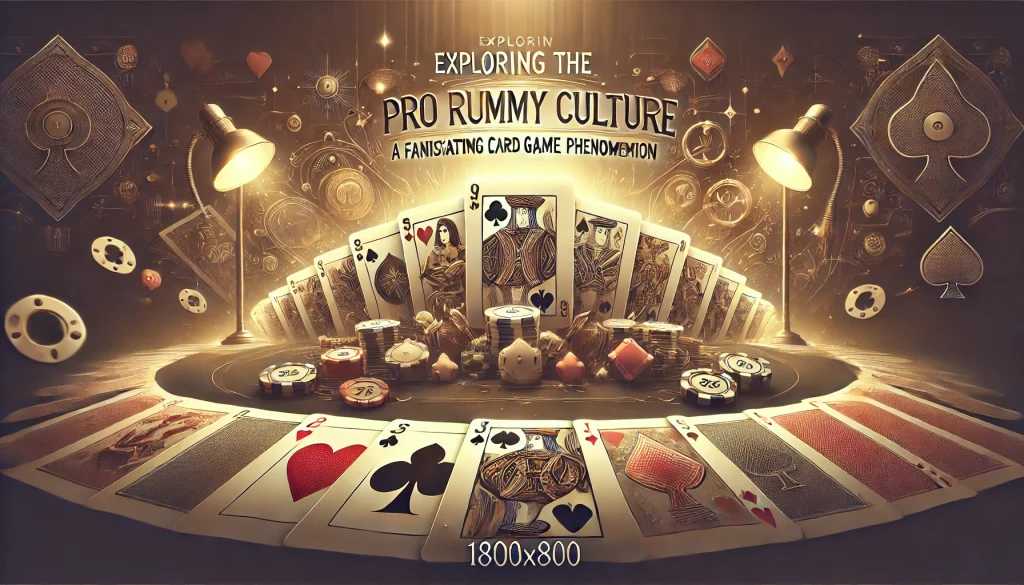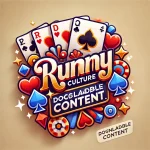
The Whole World of Rummy: An in-depth exploration of its origins, regulations, and cultural influence Rummy is a card game that has enthralled players for centuries. Its origins can be traced back to the early 1800s. It’s still unclear exactly where the game came from, but it’s generally accepted that Rummy developed from earlier card games like Conquian, which had its start in Mexico. Since the mechanics of combining cards to form sets and runs are similar, Conquian is frequently considered the forerunner of modern Rummy.
Gin Rummy, Indian Rummy, and Kalooki are just a few of the variations that have emerged as a result of the game’s many adaptations as it has expanded internationally. Every variation added distinct rules and tactics that enhanced the game’s adaptability & broad appeal. Rummy became a mainstay at family game nights and social events as it grew in popularity. Players of all ages were able to enjoy the game’s straightforward yet entertaining mechanics, which promoted friendly competition and a sense of community.
By the middle of the 20th century, rummy had become deeply ingrained in American society, & during the Great Depression, Gin Rummy gained popularity as a cheap hobby. The game gained more attention in the 1950s when television began to take off, thanks to televised tournaments that featured talented players & enhanced Rummy’s standing as a competitive hobby. Millions of fans around the world still play rummy today, taking pleasure in both classic and contemporary variations of the game.
Recognizing Rummy’s Foundations. The rules of the well-known card game rummy must be thoroughly understood by both novice and expert players. Two to six players usually participate in the game, which is played with a standard deck of cards.
Creating legitimate sets or runs by drawing and discarding cards is the primary goal. setting up runs and sets. Three or more consecutive cards of the same suit make up a run, whereas three or four cards of the same rank but different suits make up a set. Each player draws a card from the discard pile or the stockpile, & then they each discard one card from their hand. Until one player successfully melds every card into a valid combination and discards their last card, the game goes on.
Developing Your Rummy Skills. Even though the rules might appear simple, mastering Rummy calls for strategic thinking & foresight. An efficient tactic is to closely observe your opponents’ discards, as this can reveal important information about their hands and possible melds. Players should also try to maintain the flexibility of their hands by discarding cards that are unlikely to be part of their winning combinations & keeping high-value cards that are easily melded. Knowing when to play defensively versus when to go for a quick win can have a big impact on the game’s outcome, so timing is also essential.
Over the years, rummy’s competitive environment has changed significantly, leading to the emergence of professional tournaments that draw talented players from all over the world. Participants in these tournaments compete for significant cash prizes and titles in a variety of formats, such as singles and team events. The national and international governing bodies that oversee major tournaments usually make sure that they follow uniform guidelines. Rummy is elevated from a recreational activity to a serious sport by the exhilaration of competition. Professional gamers put in endless hours to improve their abilities & create cutting-edge tactics that distinguish them from amateur competitors.
During intense practice sessions, many elite players examine the playing styles of their rivals and examine previous games to spot trends and flaws. In order to hone their skills against a variety of opponents, they also frequently take part in online platforms that host competitive Rummy games. Professional athletes have a strong sense of camaraderie; they exchange strategies and advice and develop friendships that go beyond rivalry. Not only does the pro Rummy scene boost the game’s reputation, but it also encourages younger players to pick up this alluring card game.
Technology has completely changed how rummy is played and enjoyed around the world. Online platforms are now well-liked locations for both recreational and competitive play, enabling players to interact with one another across geographic borders. Now, players can compete in real-time against opponents from other nations, which improves the game’s social component & offers chances for skill improvement.
While providing sophisticated features for seasoned players looking for a challenge, these platforms frequently have user-friendly interfaces that make it simple for beginners to pick up the basics. Also, new forms and variations of Rummy that were previously unavailable in conventional settings have been introduced by online Rummy. Players can join themed games, compete in tournaments with different stakes, or even play multiplayer games that put a fun spin on traditional gameplay. The game has become increasingly popular due to the ease with which it can be played at home or on the go through mobile apps, drawing in a wide range of players, including younger generations who might not have been exposed to more conventional card games.
Internet rummy is probably going to keep growing in popularity and influence among gamers as long as technology keeps improving. Beyond simply being a card game, rummy acts as a social glue that strengthens bonds between players. Whether played in competitive or family-friendly settings, rummy promotes communication and interaction between players. The very nature of the game encourages strategic conversations and friendly banter, fostering an environment where players can connect over common experiences. Families congregate around a table for hours of gaming, laughing & sharing stories while competing against one another. This social element is especially noticeable in traditional settings.
Rummy has become a staple at community events & card game clubs, in addition to family get-togethers. Enthusiasts can gather to play & mingle at frequent tournaments or informal get-togethers hosted by numerous neighborhood organizations. In addition to giving players a chance to show off their abilities, these events foster enduring friendships within the community. Through exchanging strategies, advice, & personal stories about their Rummy experiences, players foster a sense of community that goes beyond simple rivalry. One of the many reasons rummy is still a popular game across cultures is this sense of community. Developing Problem-Solving and Critical Thinking Skills.
This mental workout promotes a number of cognitive abilities, including the ability to solve problems, recognize patterns, & make decisions under pressure. During gameplay, players develop their critical thinking skills and adjust their tactics as they move through various scenarios. enhancing the retention of memories. Also, rummy is a fantastic tool for enhancing memory recall. In addition to keeping track of possible melds in their hands, players must recall which cards have been played and discarded.
Over time, this continuous mental activity improves memory, making it a fun method to keep the mind sharp. preserving cognitive health and mental acuity. Regular engagement in mentally taxing activities, such as card games, has been linked to better cognitive health as people age, according to research. Therefore, in addition to being entertaining, playing rummy is a good way to keep your mind sharp. The impact of rummy goes well beyond table games; it has greatly influenced literature, art, entertainment, and other facets of culture.
Themes from the game frequently speak to larger cultural narratives about human interaction, competition, and strategy. Authors have often used Rummy as a metaphor for the intricacies of life in their works of literature, showing characters overcoming obstacles in a manner similar to creating melds in a game. This literary symbolism emphasizes how human experiences like taking risks, making decisions, and interacting with others are reflected in Rummy.
Besides literature, Rummy has also made its way into popular culture through television series and movies that show characters playing hard matches or using the game as a setting for important story points. In addition to providing audiences with entertainment, these representations enhance Rummy’s standing as a cultural icon that appeals to viewers of all ages. Also, artists have been influenced by the visual components of the game, producing artwork that, through vivid colors and dynamic compositions, embodies the spirit of card play. Rummy is still relevant in today’s world and has left a lasting impression on many forms of cultural expression. Several developments & trends are set to influence how rummy develops in the gaming industry as we look to the future.
The growing use of virtual reality (VR) and augmented reality (AR) technologies in online gaming is one noteworthy trend. With these developments, players will be able to play realistic card games with friends or opponents from around the globe in immersive settings that preserve the essence of traditional gameplay while fostering social interaction. A further factor that may have a big influence on how Rummy is played in the future is the increased emphasis on inclusivity in gaming communities. More & more developers are concentrating on building accessible platforms that serve a range of users by providing adaptive features for players with disabilities or beginner tutorials.
This dedication to inclusivity enhances the whole experience for all participants in addition to increasing participation. In conclusion, the development of rummy from its historical roots to its current level of popularity demonstrates its timeless appeal as a sport of competition as well as a leisure activity. A vital component of the global gaming culture, rummy continues to develop & captivate new generations of players with its rich history, strategic depth, social connections, cognitive benefits, cultural significance, and promising future trends.





